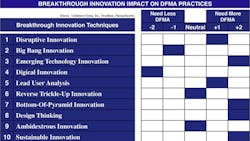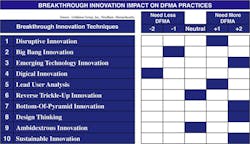Impact of Breakthrough Innovations on Design for Manufacturing and Assembly
This file type includes high resolution graphics and schematics when applicable.
Design for Manufacturing and Assembly (DFMA) is a technique well entrenched in most companies that design and build products. Originating in the late 20th Century, DFM originally focused on optimizing the design of components for rapid low-cost production, while DFA focused on optimizing designs for rapid low-cost assembly.
As the DFMA body of knowledge matured, the focus expanded to optimizing designs for reliability and serviceability. For example, changing the oil filter on a car is a dirty job. Hot engines and tight access spaces caused many service technicians to wish the oil filter was on top of the engine and easy to reach when one pops the hood. Well, by trying to optimize serviceability, it turned out reliability was reduced. Gravity takes the heavy dirt particles to the lowest point possible and a filter on top of an engine won’t catch them. And so, oil filters remained where they always were. The point is that when one tries to optimize a specific parameter, another parameter is usually degraded, and trade-off decisions have to be made.
These days, all kinds of electronics, sensors, and software are making their way into product designs. New plastics, composites, and special alloys are replacing traditional iron and steel designs. Increasingly, there are forces to make designs more environmentally friendly to manufacture and to be recyclable when the product comes to the end of its life.
This article examines the impacts of emergent breakthrough innovation techniques on the DFMA body of knowledge. In one of my previous columns, 10 distinct breakthrough innovation techniques were described. These techniques will increasingly affect the designs of new products and their ability to be manufactured or assembled. Some techniques will have great impact; others will have low or neutral impact.
Breakthrough techniques that are software intensive, such as Big Bang and Digical Innovation, will decrease the need for DFMA expertise. Techniques that cause products to be “stretched” to meet the needs of consumers at both the high and low ends of the economic spectrum—such as Reverse Trickle-Up and Ambidextrous Innovation—will likely not significantly increase or decrease the need for DFMA expertise.
Techniques that are technology driven, such as Disruptive and Emerging Technology Innovation and Lead User Analysis, where entirely new platforms result, will necessitate DFMA thinking from the beginning. Techniques that migrate and de-feature high-end products to address the needs and economic capabilities of low-end markets, such as Bottom-Of-Pyramid Innovation, will also necessitate DFMA thinking from the beginning. The re-thinking of design approaches, implied by techniques such as Design Thinking, will also likely result in intensive DFMA activity.Techniques that apply to both new products and to the re-design of existing products to minimize the environmental footprint (such as Sustainable Innovation) will likely result in the expansion and growth of the DFMA body of knowledge. “Design For X” capabilities such as Design For Environment, Design For Recyclability, and Design For Disassembly were first postulated many years ago, but there was little demand. In fact, there was actually resistance. Manufacturers did not want to trade off their ability to efficiently turn out products for both speed and cost reasons to maximize their customers’ ability to recycle a product at the end of its life. As well, societal values were not at a point where consumers would pay more for environmentally friendly products. But, times are changing and environmental friendliness is becoming more important. Studies are now showing that businesses and consumers are increasingly willing to pay a premium for products that minimize impact on the environment.
In summary, breakthrough products that disrupt markets and change the basis of competition will affect DFMA practices in the years ahead. Most breakthrough techniques will increase the need for DFMA expertise in some way. Sustainable Innovation, in particular, will likely result in the growth of nascent DFMA approaches where societal values are now becoming great enough to cause designs to be optimized for environmental impact and recyclability.
Looking for parts? Go to SourceESB.
This file type includes high resolution graphics and schematics when applicable.
About the Author
Bradford Goldense
Contributing Technical Expert
Bradford L. Goldense is founder and president of Goldense Group, Inc. [GGI] (www.goldensegroupinc.com), a consulting, market research, and education firm focused on business and technology management strategies and practices for product creation, development, and commercialization. He has been an adjunct faculty member of the graduate engineering school at Tufts University's Gordon Institute for 19 years. Goldense is a Certified New Product Development Professional [NPDP], a Certified Manufacturing Engineer [CMfgE], a Certified Computer Professional [CCP], and is Certified In Production & Inventory Management [CPIM]. He holds over 200 registered copyrights and is a recognized subject-matter expert, including appearances on PBS and CNBC. He has consulted to over 250 companies and over 750 manufacturing locations on four continents since founding GGI in 1986. Goldense holds an MBA in Accounting from the Cornell Johnson School and a BSCE from Brown University. For more information, please see Brad's LinkedIn profile or visit GGI's home page.



